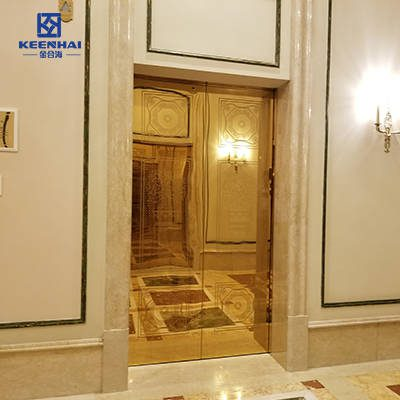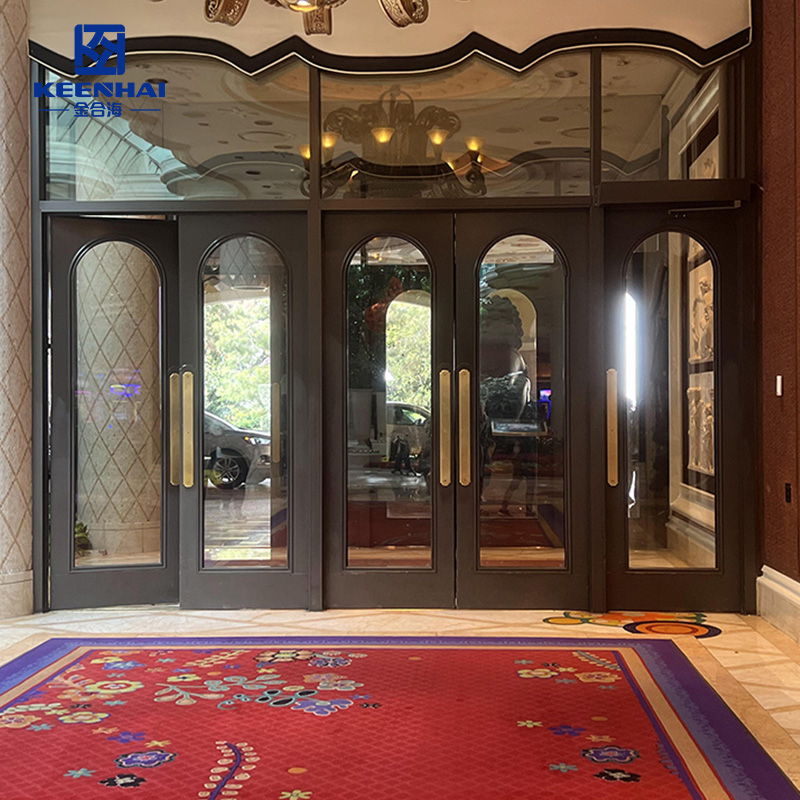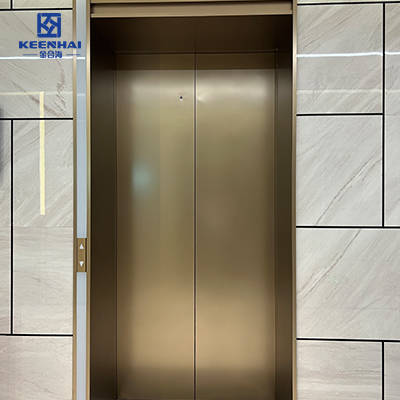Custom stainless steel elevator doors allow buildings to balance aesthetics and functionality. From mirror-polished surfaces in luxury hotel lobbies to matte brushed finishes in high-traffic offices, designers can select materials, textures, and lighting options that enhance safety, durability, and visitor experience without sacrificing style.
1. Design Options
Designing a custom stainless steel elevator door requires understanding the range of finishes and textures available. Each option impacts aesthetics, maintenance, and user experience, so selecting the right design is critical for both high-traffic commercial buildings and luxury environments.
1.1 Mirror and Polished Finishes
Mirror and polished finishes provide a reflective, high-gloss surface that enhances visual space and delivers a premium look.
-
Applications: Luxury hotels, boutique offices, and high-end residential lobbies.
-
Benefits:
-
Creates a sense of depth in tight spaces.
-
Enhances lighting effects by reflecting ambient light.
-
Offers smooth, easy-to-clean surfaces suitable for moderate daily use.
-
Maintenance Tips: Wipe with a microfiber cloth daily, and polish monthly with a stainless steel cleaner to prevent fingerprints and water spots.
Example: In a 20-floor boutique hotel, mirror-finished doors were installed in the main lobby to amplify natural light, creating a visually striking entry that complements marble flooring and LED accent lighting.
1.2 Brushed and Etched Patterns
Brushed and etched patterns deliver a more subtle texture that hides scratches and fingerprints, ideal for heavy-traffic areas.
-
Applications: Airports, corporate offices, hospitals.
-
Benefits:
-
Durable and scratch-resistant surface.
-
Reduces visible smudges in areas with high daily usage.
-
Offers a wide variety of etched patterns for aesthetic customization.
-
| Finish Type | Visibility of Scratches | Fingerprint Resistance | Ideal Traffic Level | Typical Use Case |
|---|---|---|---|---|
| Brushed | Low | High | High | Corporate lobbies, hospitals |
| Etched Pattern | Μέσον | High | Medium-High | Retail centers, boutique lobbies |
Example: A corporate tower with six stainless steel elevator entrances used brushed steel doors to maintain a professional look while minimizing visible wear in heavy daily traffic exceeding 2,000 people.
1.3 PVD-Coated and Custom Colors
PVD (Physical Vapor Deposition) coatings offer a long-lasting, corrosion-resistant finish available in custom colors.
-
Applications: Coastal resorts, luxury apartments, boutique office spaces.
-
Benefits:
-
Maintains color and sheen for over a decade even in humid or salty environments.
-
Supports unique branding or interior color schemes.
-
Resistant to chemical cleaners and heavy use
-
Maintenance Tips: Clean monthly with a soft cloth and mild detergent. Avoid abrasive materials to prevent coating damage.
Example: A beachfront hotel installed gold PVD-coated elevator doors in the main lobby to match decorative columns and ambient lighting, providing a luxurious and durable entrance that withstands coastal humidity.
1.4 Textured and Engraved Panels
Textured or engraved panels allow for artistic customization while adding functional benefits like improved grip and reduced visible wear.
-
Applications: Museums, high-end retail stores, boutique offices.
-
Benefits:
-
Adds tactile appeal and architectural interest.
-
Custom engravings can incorporate logos or thematic patterns.
-
Slight texture reduces the visibility of minor scratches and fingerprints.
-
Installation Tips: Panels should be installed by experienced professionals to ensure alignment of engravings with overall design, preventing mismatched patterns across elevator doors.
Example: In a museum lobby, textured stainless steel panels featuring subtle geometric engravings were used on elevator doors to complement exhibit motifs, creating a cohesive and visually engaging experience for visitors.
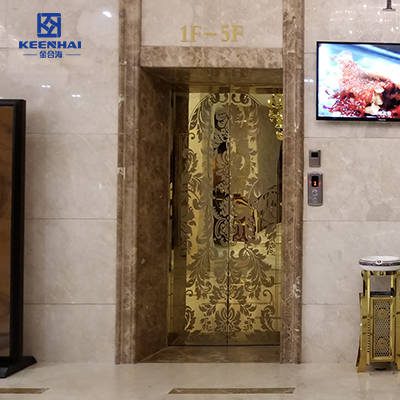
2. Material Choices
Selecting the right material for custom elevator doors significantly affects durability, maintenance, and visual appeal. Material choice ensures doors can withstand daily use, resist corrosion, and complement interior finishes without compromising performance.
2.2 Corrosion-Resistant Coatings
Additional coatings extend the lifespan of stainless steel and add aesthetic options.
-
PVD Coatings: Provide colored finishes (gold, bronze, black) that resist fading and scratching.
-
Electropolishing: Smooths the surface, enhances corrosion resistance, and makes cleaning easier.
-
Clear Lacquer: Adds a protective layer against fingerprints and moisture, suitable for high-touch areas.
Example: In a high-traffic hospital lobby, electropolished stainless steel elevator doors reduced cleaning time by 30% and kept surfaces free from staining even with frequent disinfectant use.
2.3 Thickness and Panel Reinforcement
Door thickness directly impacts structural strength and durability.
-
Standard Thickness: 1.2–1.5 mm panels work well for most commercial applications.
-
Heavy-Duty Panels: 2.0 mm or reinforced panels are ideal for high-traffic public buildings like airports or shopping centers.
-
Reinforcement: Internal crossbars or frame reinforcements prevent warping and vibration, enhancing long-term reliability.
Example: A corporate tower with over 10,000 daily elevator rides installed reinforced 2 mm brushed doors, significantly reducing wear and preventing misalignment over 8 years of continuous operation.
2.4 Compatibility with Other Interior Materials
Custom elevator doors should harmonize with surrounding design elements for a cohesive aesthetic.
-
Metal Combinations: Pair stainless steel doors with brass, bronze, or aluminum accents for luxurious interiors.
-
Glass Integration: Etched or frosted glass panels can be combined with steel for visual depth and light diffusion.
-
Wood and Stone Coordination: Brushed or textured steel can complement marble floors, granite walls, or wooden trim without looking out of place.
Example: In a boutique hotel lobby, mirror-finished stainless steel elevator entrances aligned perfectly with marble flooring and walnut wall panels, creating a visually balanced and upscale entrance.
3. Lighting and Reflectivity Integration
Integrating lighting and reflectivity into custom stainless steel elevator doors enhances both aesthetics and functionality. Properly designed illumination and reflective surfaces can make lobbies feel more spacious, improve user experience, and highlight design details.
3.1 LED and Accent Lighting Options
Incorporating LED lighting around elevator doors or within panel recesses creates a modern, visually striking effect.
-
Applications: Luxury hotels, high-end residential buildings, boutique offices.
-
Benefits:
-
Enhances architectural features and brand identity.
-
Improves visibility and safety in dimly lit lobbies.
-
Supports energy-efficient solutions with minimal heat output.
-
Example: In a five-star hotel, stainless steel elevator entrances with integrated warm LED accent lighting highlighted the lobby’s polished marble floors and textured wall panels, providing both luxury appeal and functional illumination for over 400 daily visitors.
3.2 Reflective vs Matte Surface Effects
The choice between reflective and matte finishes affects both perception of space and maintenance requirements.
-
Reflective Finishes: Mirror or polished surfaces amplify light, visually expanding confined lobbies and creating a premium feel. Ideal for areas where aesthetics and guest impressions are paramount.
-
Matte or Brushed Finishes: Reduce glare, hide fingerprints, and are practical for high-traffic areas. Suitable for airports, hospitals, and corporate environments where daily wear is significant.
| Finish Type | Light Amplification | Fingerprint Visibility | Maintenance Needs | Best Use Case |
|---|---|---|---|---|
| Reflective | High | High | Frequent | Hotels, luxury residential |
| Matte/Brushed | Μέσον | Low | Moderate | Airports, offices, hospitals |
Example: A corporate lobby with high visitor turnover installed matte brushed panels on elevator doors, balancing professional aesthetics with reduced cleaning demands, while reflective panels were used on guest elevators to impress VIP visitors.
3.3 Enhancing Spatial Perception with Finishes
Combining reflective surfaces with lighting creates the illusion of depth, making compact lobbies feel larger.
-
Use mirror finishes to double visual space when walls are limited.
-
Integrate soft LED strips at door edges to guide the eye upward and outward.
-
Consider subtle etched patterns on reflective panels to diffuse glare without compromising brightness.
Example: In a boutique office building with a 12-foot lobby ceiling, polished stainless steel elevator doors paired with horizontal LED lighting strips created a perception of height and openness, improving both aesthetic impact and visitor experience.
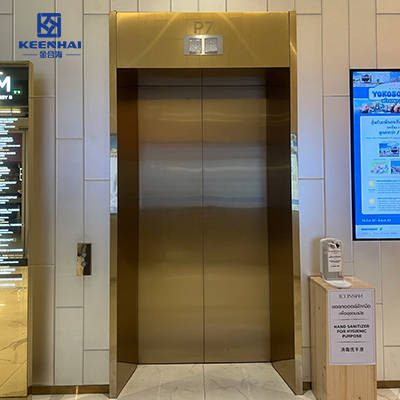
4. Functional Customization
Functional customization of stainless steel elevator doors ensures the final design not only looks impressive but also performs reliably in its intended environment. This includes selecting door operation types, safety features, and accessibility options tailored to specific building requirements.
4.1 Automatic vs. Manual Operation
Choosing between automatic sliding, swing, or manual doors affects convenience, safety, and traffic flow.
-
Automatic Doors: Use sensors or push-buttons to open seamlessly, ideal for commercial buildings, hospitals, and luxury hotels. Reduces physical contact and improves accessibility for high-traffic areas.
-
Manual Swing Doors: More traditional, reliable in low-traffic spaces, and easier to maintain. Preferred for boutique offices or historic buildings where aesthetic continuity matters.
Example: In a corporate tower with over 3,000 daily elevator rides, automatic sliding stainless steel elevator doors were installed to streamline traffic, reduce wait times, and minimize maintenance issues compared to traditional manual doors.
4.2 Accessibility and Safety Features
Integrating ADA-compliant features and safety measures is essential for modern buildings.
-
Install low-force opening mechanisms for wheelchair users.
-
Add tactile panels or braille signage to guide visually impaired visitors.
-
Include anti-pinch and emergency stop features to prevent accidents in high-traffic environments.
Example: A hospital installed automatic brushed stainless steel doors with ADA-compliant sensors and tactile braille panels, ensuring safe and convenient access for patients, staff, and visitors 24/7.
4.3 Integration with Building Systems
Custom elevator doors can be synchronized with lighting, access control, and fire alarm systems to enhance overall functionality.
-
Access Control Integration: Connect with card readers or biometric systems for secure office or residential buildings.
-
Lighting Synchronization: Doors can trigger ambient lighting upon opening, improving visibility and aesthetic impact.
-
Fire Safety Coordination: Doors can automatically unlock or close in emergencies, working seamlessly with building fire systems.
Example: In a luxury apartment complex, stainless steel elevator entrances were integrated with smart lighting and access control systems. Residents experienced smooth door operation, automated lobby lighting, and enhanced security, while maintenance teams benefited from remote monitoring capabilities.
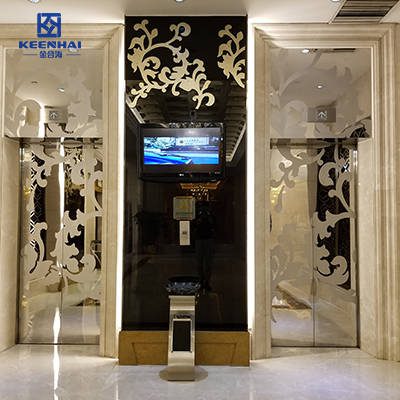
5. Maintenance and Longevity Recommendations
Proper maintenance ensures custom stainless steel elevator doors remain visually appealing and function reliably over decades. Regular care, preventive measures, and timely repairs reduce wear, extend lifespan, and preserve both safety and aesthetics.
5.1 Cleaning and Surface Care
Regular cleaning prevents surface damage and maintains a polished appearance.
-
Use microfiber cloths or soft sponges to remove fingerprints, dust, and smudges.
-
Apply stainless steel cleaners or mild detergents monthly to maintain luster without damaging coatings.
-
Avoid abrasive pads or harsh chemicals that could scratch or discolor surfaces.
Example: A 15-story office building implemented a weekly cleaning schedule for stainless steel elevator doors, reducing visible smudges by 80% and minimizing long-term maintenance costs over 5 years.
5.2 Mechanical and Hardware Maintenance
Maintaining door hardware ensures smooth operation and prevents downtime.
-
Lubricate hinges, tracks, and rollers every 3–6 months depending on traffic.
-
Inspect sensor systems and automatic opening mechanisms quarterly for consistent performance.
-
Replace worn or misaligned panels promptly to avoid further wear and operational issues.
Example: In a hotel with over 600 daily elevator rides, quarterly hardware inspections on polished elevator doors prevented sensor malfunctions and kept doors operating seamlessly, improving guest satisfaction and reducing repair expenses.
5.3 Long-Term Protection Strategies
Proactive strategies preserve both function and aesthetics over time.
-
Apply protective coatings or wax treatments on high-touch surfaces to resist fingerprints and corrosion.
-
Schedule annual professional inspections to check structural integrity, especially for reinforced or PVD-coated doors.
-
Monitor environmental factors such as humidity, salt air, or harsh cleaning agents, which can accelerate wear.
Example: A beachfront resort used pvdstainlesssteel reinforced PVD-coated elevator doors. Annual inspections and protective surface treatments ensured doors remained corrosion-free and visually stunning despite high humidity and salt exposure.

